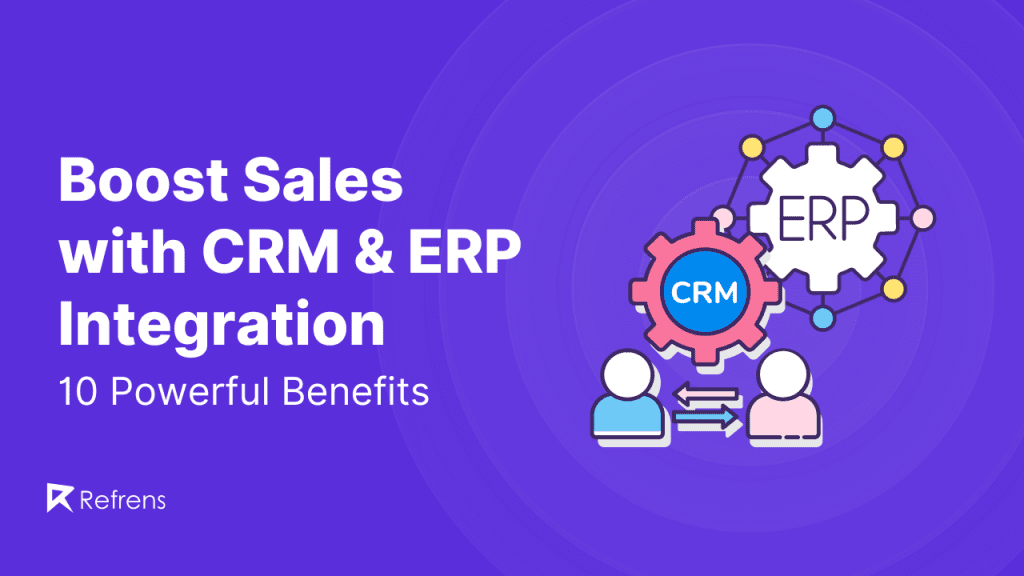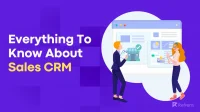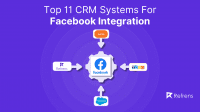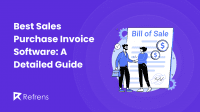Businesses want to streamline their operations and improve efficiency to increase sales and bring more profits.
If a business is focussing on increasing sales, then the duty of the sales department should be more focused on building relationships and closing deals. At the same time, managers require clear insights to guide strategic decision-making. Hence, Customer Relationship Management (CRM) and Enterprise Resource Planning (ERP) systems are used to manage the sales workflow.
Sales CRM: Your Customer Powerhouse
A sales CRM acts as a central hub for all your customer interactions. It streamlines lead management, tracks opportunities, and promotes stronger relationships. The sales team can access customer data, communication history, and purchase behavior, allowing them to personalize their approach and identify upselling opportunities.
ERP: The Backbone of Your Business Operations
An ERP system integrates core business functions like inventory management, order processing, and accounting. It provides real-time data on product availability, pricing, and production schedules, helping salespeople to quote accurate prices, check stock levels, and ensure timely deliveries, building trust with customers.
The Benefits of Integration
Here are ten ways a seamlessly integrated CRM and ERP system can skyrocket your sales performance:
- Enhanced Lead Qualification: The primary benefit is that the CRM data can be filled with real-time insights from the ERP about a prospect’s purchase history and buying patterns. The sales team can then prioritize leads with higher conversion potential and tailor their pitches accordingly.
- Accurate Quoting and Order Processing: Integration eliminates the risk of quoting the wrong price or promising a delivery date that can’t be met. Sales reps have immediate access to accurate inventory levels and production schedules, leading to faster order processing and happier customers.
- Improved Sales Forecasting: Historical sales data from the CRM can be combined with real-time production and inventory information from the ERP to generate more accurate sales forecasts. This allows managers to optimize resource allocation and adjust strategies for better lead generation.
- Streamlined Sales Pipeline Management: Sales reps can track the progress of opportunities through the pipeline with greater clarity. ERP data like product availability and pricing updates seamlessly flow into the CRM, ensuring the pipeline reflects the latest information.
- Data-Driven Decision-Making: Integrated systems provide a holistic view of customer interactions, sales performance, and operational realities. Managers can leverage these insights to find trends, optimize pricing strategies, and make better decisions to drive sales growth.
- Improved Customer Service: With a unified customer profile, sales reps gain a comprehensive view of a customer’s interactions across channels. Leveraging AI for customer service, they can provide highly personalized support, address inquiries with greater efficiency, and resolve issues swiftly, ensuring improved customer satisfaction and fostering loyalty.
- Increased Sales Rep Productivity: Integration eliminates the need for manual data entry between systems. Sales executives can spend less time on administrative tasks and more on high-value activities like nurturing leads and closing deals, boosting overall productivity.
- Enhanced Collaboration Between Departments: Sales, marketing, and operations teams can work together seamlessly with a single source of truth. Shared data fosters better communication, eliminates information silos, and ensures everyone is on the same page, leading to more effective sales campaigns.
- Improved Reporting and Analytics: Integrated systems provide comprehensive sales reports with CRM and ERP insights. This makes it easier to track KPIs, find improvement areas, and measure the ROI of sales initiatives.
- Reduced Costs and Increased Profitability: An integrated CRM and ERP system or ERP AI chatbot system can significantly reduce operational costs by streamlining processes, improving efficiency, and boosting sales performance. This translates into higher profits and increased business sustainability.
The Road to Sales Success
Integrating a CRM and ERP system can be a game-changer for your sales team. The Road to Sales Success can be accelerated by following guidelines in the integration as a service playbook, which provides a structured approach to integrating systems like CRM and ERP. However, choosing the right software and ensuring a smooth integration process are crucial for success. System integration testing is essential to validate that all components work together seamlessly. Here are some key points to consider, along with additional details to guide you on your journey:
- Identify Your Needs:
- Go beyond generalities. Don’t simply aim for “increased sales performance.” Delve deeper. Are you struggling with inaccurate quotes due to outdated inventory data? Is lead qualification a bottleneck in your sales cycle? Identifying specific pain points will help you choose an integration solution that directly addresses those challenges.
- Consider future scalability. Don’t just pick a system based on your current size. Think ahead – will the chosen solution accommodate your growth plans?
- Choose the Right CRM and ERP:
- Focus on native integrations. Look for software vendors who offer pre-built connectors between their CRM and ERP systems. This ensures a smoother integration process and reduces the risk of compatibility issues.
- Evaluate user experience. The system should be user-friendly and intuitive for your sales team. A clunky interface can hinder adoption and negate the benefits of integration.
- Security is paramount. Ensure the CRM and ERP systems offer strong security features to protect the data of customers and businesses.
- Data Migration and Cleansing:
- Prepare for data inconsistencies. Duplicate records, outdated information, and formatting errors are common issues in any database. Dedicate time and resources to data cleansing before migration to ensure the accuracy and integrity of your integrated system.
- Develop a data governance plan. Establish clear guidelines for data ownership, access control, and update procedures. This will minimize the risk of future data quality issues.
- User Training and Adoption:
- Go beyond technical training. While familiarizing your team with the functionalities of the integrated system is important, also focus on teaching them how to leverage the new capabilities to improve their sales strategies and customer interactions.
- Provide ongoing support. Be prepared to offer ongoing support and answer questions as your team adjusts to the new system. Consider creating user guides and knowledge base articles for easy reference.
- Optimizing for Success:
- Change management is key. Integrating ERP and sales CRM systems can significantly alter your sales workflow. Implementing a strong change management strategy will help your team adapt smoothly and maximize the new system’s benefits.
- Embrace automation. Explore the integrated system’s automation features. Automating repetitive tasks can free up your sales team’s time. They can focus on other work, such as building relationships and closing deals.
- Maximizing your ROI. Track key metrics such as sales cycle length, conversion rates, and customer satisfaction before and after integration. This will help you quantify the impact of the integration on your sales performance and overall business success.
Concluding Words
Organizations can empower their sales team, improve customer satisfaction, and take their business towards sustained sales growth by following the above steps and harnessing the power of CRM and ERP integration.


















